
Béla Ferenc Dezső Blaskó, known professionally as Bela Lugosi, was a Hungarian–American actor, best remembered for portraying Count Dracula in the 1931 horror film classic Dracula, Ygor in Son of Frankenstein (1939) and his roles in many other horror films from 1931 through 1956.

Bride of the Monster is a 1955 American independent science fiction horror film, co-written, produced and directed by Edward D. Wood Jr., and starring Bela Lugosi and Tor Johnson with a supporting cast featuring Tony McCoy and Loretta King.

Mark of the Vampire is a 1935 American horror film, starring Lionel Barrymore, Elizabeth Allan, Bela Lugosi, Lionel Atwill, and Jean Hersholt, and directed by Tod Browning. A series of deaths and attacks by vampires brings the eminent expert Professor Zelen to the aid of Irena Borotyn, who is about to be married. Her father, Sir Karell, died from complete loss of blood, with bite wounds on his neck, and it appears he may be one of the undead now plaguing the area.

Bela Lugosi (1882–1956), best known for the original screen portrayal of Bram Stoker's Dracula in 1931, performed in many films during the course of his 39-year film career. He appeared in films made in his native Hungary, Germany and New York before re-locating to Hollywood in 1928. Films are listed in order of release.
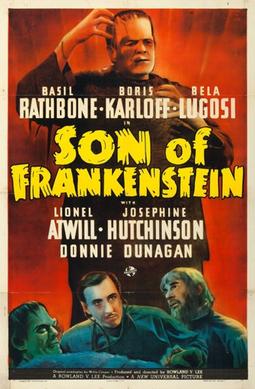
Son of Frankenstein is a 1939 American horror film directed by Rowland V. Lee and starring Basil Rathbone, Boris Karloff and Bela Lugosi. The film is the third in Universal Pictures' Frankenstein series and is the follow-up to the 1935 film Bride of Frankenstein. Son of Frankenstein stars Rathbone as Baron Wolf von Frankenstein who, with his wife Elsa and son Peter, returns to his late father's estate. Near the castle lives Ygor, a crazed blacksmith whose neck was broken in an unsuccessful hanging attempt. Among the castle's remains, Frankenstein discovers the remains of the Monster and decides to try to save his family name by resurrecting the creature to prove his father was correct. He finds, however, the Monster only responds to Ygor's commands.

Invisible Ghost is a 1941 American horror film directed by Joseph H. Lewis, produced by Sam Katzman and starring Bela Lugosi.

Horace Raymond Huntley was an English actor who appeared in dozens of British films from the 1930s to the 1970s. He also appeared in the ITV period drama Upstairs, Downstairs as the pragmatic family solicitor Sir Geoffrey Dillon.

The Raven is a 1935 American horror film directed by Louis Friedlander and starring Boris Karloff and Béla Lugosi. Billed as having been "suggested by" Edgar Allan Poe's 1845 poem of the same title, excerpts of which are quoted at a few points in the film, it was adapted from an original screenplay by David Boehm. Lugosi stars as a neurosurgeon obsessed with Poe who has a torture chamber in his basement, and Karloff plays an escaped murderer on the run from the police who Lugosi manipulates into doing his dirty work.

Murders in the Rue Morgue is a 1932 American horror film directed by Robert Florey, based on Edgar Allan Poe's 1841 short story "The Murders in the Rue Morgue". The plot is about Doctor Mirakle, a carnival sideshow entertainer and scientist who kidnaps Parisian women to mix their blood with that of his gorilla, Erik. As his experiments fail because of the quality of his victims' blood, Mirakle meets with Camille L'Espanye, and has her kidnapped and her mother murdered, leading to suspicion falling on Camille's fiance, Pierre Dupin, a medical student who has already become interested in the earlier murders.

The Phantom Creeps is a 1939 12-chapter science fiction horror serial starring Bela Lugosi as mad scientist Doctor Zorka, who attempts to rule the world by creating various elaborate inventions. In a dramatic fashion, foreign agents and G-Men try to seize the inventions for themselves.
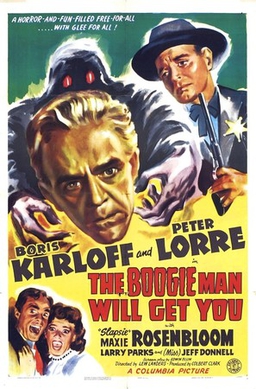
The Boogie Man Will Get You is a 1942 American comedy horror film directed by Lew Landers and starring Boris Karloff and Peter Lorre. It was the final film Karloff made under his contract with Columbia Pictures, and it was filmed in the wake of his success in the 1941 Broadway production Arsenic and Old Lace. As he had done several times previously, Karloff played the part of a "mad scientist", Professor Billings, who is using the basement of his inn to conduct experiments using electricity to create a race of superhumans. The inn is bought by a new owner, who is initially unaware of the work Billings is conducting.
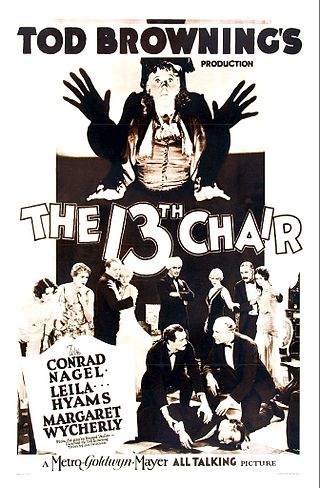
The Thirteenth Chair is a 1929 American mystery film directed by Tod Browning. The picture is based on a 1916 play of the same name by Bayard Veiller. It stars Conrad Nagel, Leila Hyams and Margaret Wycherly.

The Dark Eyes of London is a 1939 British horror film produced by John Argyle and directed by Walter Summers, and starring Béla Lugosi, Hugh Williams, and Greta Gynt. The film is an adaptation of the 1924 novel of the same name by Edgar Wallace. The film is about a scientist named Dr. Orloff who commits a series of murders for insurance money, while periodically disguising himself as the blind manager of a charity to further his scheme.

Ghosts on the Loose is a 1943 American comedy horror film and the fourteenth film in the East Side Kids series, directed by William Beaudine. The picture co-stars horror film icon Bela Lugosi as well as Ava Gardner in one of her earliest roles.
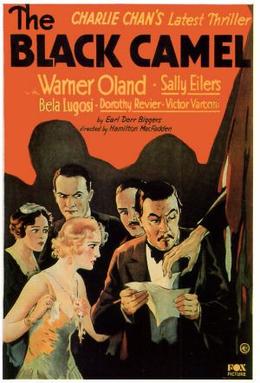
The Black Camel is a 1931 American pre-Code mystery film directed by Hamilton MacFadden and starring Warner Oland, Sally Eilers, Bela Lugosi, and Dorothy Revier. It is based on the 1929 novel of the same name by Earl Derr Biggers. It is the second film to star Oland as detective Charlie Chan, and the sole surviving title of the first five Chan films starring Oland. The Black Camel marked the film debut of Robert Young.

Postal Inspector is a 1936 American crime film directed by Otto Brower and starring Patricia Ellis, Ricardo Cortez and Bela Lugosi. It was produced and distributed by Universal Pictures.

Night of Terror is a 1933 American pre-Code horror film directed by Benjamin Stoloff, and starring Bela Lugosi, Sally Blane, Wallace Ford, and Tully Marshall. Despite receiving top billing, Bela Lugosi has a relatively small part. The film is also known as He Lived to Kill and Terror in the Night.

Mother Riley Meets the Vampire is a 1952 British horror comedy film directed by John Gilling, starring Arthur Lucan and Bela Lugosi. It was filmed at Nettlefold Studios.
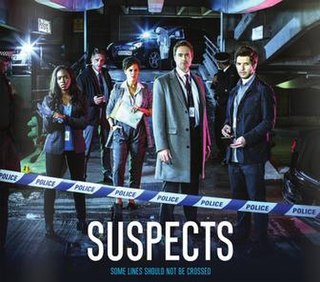
Suspects is a British police procedural television series that aired on Channel 5 from 12 February 2014 to 31 August 2016. The series follows members of the Metropolitan Police as they investigate murders, assaults, and other crimes across London.

Joanne Ratcliffe and Kirste Jane Gordon were two Australian girls who went missing while attending an Australian rules football match at the Adelaide Oval on 25 August 1973. Their disappearance, and presumed abduction and murder, became one of South Australia's most infamous crimes. The presumed murders are thought by South Australia Police and the media to be related to the disappearance of the Beaumont children in 1966. The case is sometimes referred to as the Adelaide Oval abductions.




















